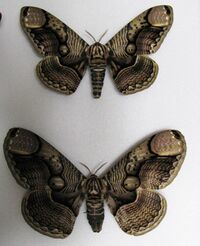Biology:Brahmaea wallichii
| Brahmaea wallichii | |
|---|---|

| |
| Subspecies B. w. insulata | |
| Scientific classification | |
| Domain: | Eukaryota |
| Kingdom: | Animalia |
| Phylum: | Arthropoda |
| Class: | Insecta |
| Order: | Lepidoptera |
| Family: | Brahmaeidae |
| Genus: | Brahmaea |
| Species: | B. wallichii
|
| Binomial name | |
| Brahmaea wallichii Gray, 1831[1]
| |
| Synonyms | |
| |
Brahmaea wallichii, also known as the owl moth, is a moth from the family Brahmaeidae, the Brahmin moths, and one of its largest species. It is found in the north of India , Nepal, Bhutan, Myanmar, China , Taiwan, and Japan . The owl moth is nocturnal.[3] The wingspan is about 90–160 millimetres (3 1⁄2–6 1⁄4 inches).[4]
Appearance
The moth has well-developed eye spots on the front wings and a characteristic pattern of black-brown stripes. The light-brown margins of the back wings display small triangular white spots. The robust body is also black and brown, with characteristic orange-brown stripes.[4]
Etymology
The species is named after the botanist Nathaniel Wallich.
Behavior
The larvae feed on Fraxinus excelsior, Ligustrum and common lilac. In captivity they also feed on elderberry.[4] They are able to neutralize plant toxins produced by Ligustrum.[5]
The moths are active at night; during the daytime, they rest with outspread wings on tree trunks or on the ground. When disturbed, the moth does not fly away, but fiercely shakes.[4]
Habitat
The habitat is both tropical and temperate forests.[4]
Subspecies
- Brahmaea wallichii wallichii
- Brahmaea wallichii insulata Inoue, 1984 (Taiwan)
- Brahmaea wallichii saifulica de Freina, 1983 (western Himalaya)
References
| Wikimedia Commons has media related to Brahmaea wallichii. |
- ↑ Gray, J.E. (1831): Description of a new species of Bombyx from Nepaul, discovered by Dr. WALLICH. — The Zoological Miscellany (London), 1, 1831: 39. scan
- ↑ Savela, Markku (November 24, 2002). "Genus Brahmaea". funet.fi. http://www.funet.fi/pub/sci/bio/life/insecta/lepidoptera/ditrysia/bombycoidea/brahmaeidae/brahmaea/index.html. Retrieved 2009-03-09.
- ↑ Carter, David (2002). Butterflies and Moths (Second ed.). United States: Dorling Kindersley. pp. 304. ISBN 0-7894-8983-X.
- ↑ 4.0 4.1 4.2 4.3 4.4 Carter, David J. (1993) (in nl). Vlinders (translated book) (First (translated) ed.). Baarn: Bosch & Keuning. pp. 216. ISBN 90-246-4923-4.
- ↑ Kotaro Konno; Sachiko Okada; Chikara Hirayama (2001). "Selective secretion of free glycine, a neutralizer against a plant defense chemical, in the digestive juice of the privet moth larvae". Journal of Insect Physiology 47 (12): 1451–1457. doi:10.1016/S0022-1910(01)00135-4. PMID 12770151.
Wikidata ☰ Q528841 entry
 |


